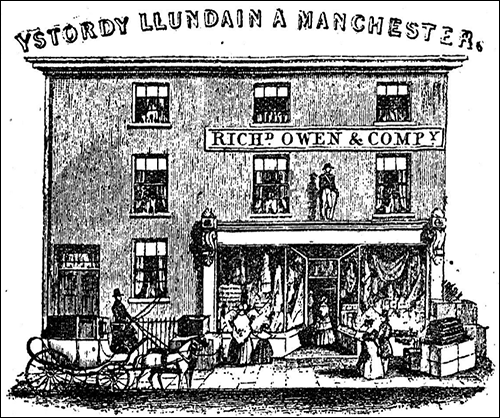Mill Lane or Gardd’rafon, Caernarfon
 This short street was still named as Mill Lane on street signs in the 1970s. It led from Turf Square (or Pendist) towards the site of a mill which once stood near Afon Cadnant at the bottom of the slope.
This short street was still named as Mill Lane on street signs in the 1970s. It led from Turf Square (or Pendist) towards the site of a mill which once stood near Afon Cadnant at the bottom of the slope.
The street is named Garddr’afon, meaning “garden of the river”, on John Wood’s 1834 map of Caernarfon. These features are named as Town Mill in an 1816 document, and Velin y Dre and Gardd Yr Afon in an 1857 document.
 By the 1840s, the mill leat had been used for the foundations of the rear wall of a large shop, the Nelson Emporium (pictured). The sloping terrain made the rear wall taller than the three-storey street frontage, where a statue of Lord Nelson stood above the shop entrance.
By the 1840s, the mill leat had been used for the foundations of the rear wall of a large shop, the Nelson Emporium (pictured). The sloping terrain made the rear wall taller than the three-storey street frontage, where a statue of Lord Nelson stood above the shop entrance.
In 1848 the Coed Helen Estate was asked to remove stagnant water from Penllyn and to remove the “cast iron wheels, which are at Garddrafon and are a nuisance there”. In 1867 many of the houses in Gardd’rafon were described as “no better than dunghills”.
In his history of Caernarfon from 1793 to 1900, Dr Lewis Lloyd described Mill Lane as a “den of iniquity” where most of the brothels were kept by women and the prostitutes were mainly Welsh, with some Irish and English.
In 1864 prostitute Elizabeth Roberts was charged with being drunk and riotous in Mill Lane at about 4am on a Saturday. A police officer heard a great noise in the lane, where he found Elizabeth half dressed in the street and six or seven sailors from Jersey “about the house”. Her case was dismissed after she explained that the men had broken a door, furniture and glass in the house and torn her clothes.
In 1872 prostitute Elizabeth Morgan, aged 44, was jailed for a year with hard labour for attacking Richard Owen, her next door neighbour, with a poker at her house in Mill Lane.
With thanks to Caernarfon Civic Society. Sources include the National Library of Wales
Postcode: LL55 1AN

